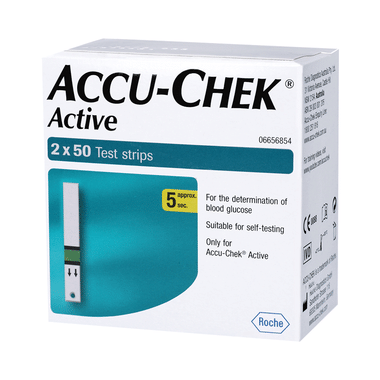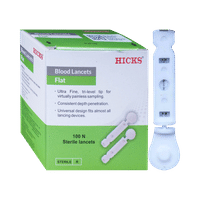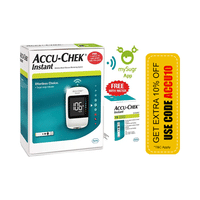Accu-Chek Active Test Strip (Only Strips)
(100 Test Strips in box)
Rs. 1958
Rs. 1998
2% off
Rs. 1958
Rs. 1998
2% off
Available in other variants

Product Details
Accu-Chek Active Test Strip
It helps in determining the blood sugar level in the body. It facilitates hassle-free usage as it does not require any manual coding. These sugar strips absorb blood easily and show reliable results in a few seconds. It helps to get quick and reliable results in the comfort of your place. It can be used for both professional (at clinics) and personal (at home) use. It is effortless to use.
Note: The Accu-Chek strips are available in packs of 10, 25, and 50 stripes
Uses:
It helps regulate blood sugar levels.
Product Specifications and Features:
Compatible with: Accu-Chek Active Glucometer
Directions for Use:
Safety Information:
Quick Tips:
Frequently Asked Questions:
Q. Can blood sugar strips be reused?
No. All the blood glucose test strips are for single use only. Do not reuse a test strip, as it may not provide the appropriate results. It is strongly advised always to discard a test strip after every use.
Q. What are the benefits of glucometers?
It is well known that testing blood glucose levels with a glucometer at home is one of the best ways to regulate blood sugar levels. It can help to test blood glucose at any time of the day and anywhere. Using a portable glucometer is the best way to test glucose when travelling. Charting blood glucose levels becomes easy with glucometers, especially with devices with memory options to store previous readings. By helping to check blood glucose, blood glucose monitors can help manage blood glucose levels.
Q. What is a normal glucometer reading?
According to the American Diabetes Association, the fasting or preprandial blood glucose levels for diabetics should be between 80 – 130 mg/dl, and postprandial (1-2 hours after meals) should be less than 180 mg/dl. However, the range mentioned in the glucose monitor may be a little different. So, speak to the doctor to calibrate the results with the lab reports.
Q. How do blood glucose monitors work?
Diabetes devices or glucometers test the amount of glucose in the blood. The test strips in glucometers contain an enzyme glucose oxidase, which reacts with glucose in the blood and sends the result as an electronic signal displayed on the monitor.
Q. How often blood glucose levels should be tested with a glucometer?
In the case of type 1 diabetes, check the blood glucose levels several times a day, such as pre and post-meals and before and after exercise or as advised by the doctor. Whereas, in the case of type 2 diabetes, monitoring the sugar levels might be based on the severity of the condition, which can be several times a day, once a day, or thrice a week. Hence, talk to the doctor about how often blood glucose levels should be tested.
Warranty Info (if applicable)
It helps in determining the blood sugar level in the body. It facilitates hassle-free usage as it does not require any manual coding. These sugar strips absorb blood easily and show reliable results in a few seconds. It helps to get quick and reliable results in the comfort of your place. It can be used for both professional (at clinics) and personal (at home) use. It is effortless to use.
Note: The Accu-Chek strips are available in packs of 10, 25, and 50 stripes
Uses:
It helps regulate blood sugar levels.
Product Specifications and Features:
- Blood volume: 1-2 μl
- Measuring interval: 10-600 mg/dL
- Measuring time of the test strip in the meter: Approx. 5 seconds
- Measuring time of the test strip outside the meter: Approx. 08 seconds
- Sample types: Capillary blood
- Re-dosing capability: Additional blood can be added to the test strip within 10 seconds after applying the first drop (applies for inside mode)
- Hematocrit range: 20 – 55 % (within-meter mode), 20 – 70 % (outside-meter mode)
- It has ISO 15197:2013 standards of accuracy
- Accu-Chek active strip is a hassle-free product and has clever functionality
- The blood spreads across the strip and automatically absorbs the blood to provide a fast and accurate result
- A clear protective barrier along the entire length of the test strip protects the strip and makes the strip easy to handle
- Accu-Chek active allows double-checking the displayed results to ensure accurate blood glucose measurement
- The strips contain chip code and do not require any manual coding
Compatible with: Accu-Chek Active Glucometer
Directions for Use:
- Remove a single diabetes test strip from the box of strips
- Insert the glucose test strip
- Prick the finger with the lancet to draw out a blood drop
- Carefully touch the blood drop onto the green field of the test strip
- Read the blood glucose result
Safety Information:
- Read the manual/instruction leaflet carefully before use
- Store in a cool and dry place, away from sunlight
- Keep out of reach of children
- Each strip is for single use only
- Dispose of the used strips properly
- Test strip container must be tightly closed after each strip is removed
Quick Tips:
- For in-vitro diagnostic use, only
- Store in a capped vial in a cool and dry space between 4-30 degrees Celsius
- Discard any remaining test strips three months after the first opening of the vial
- Do not take any medical decisions without consulting a doctor
- Always discuss the results with a registered medical practitioner
- It is wise to check the test strips before use carefully for better results
- Always check the expiry date on the test strips and lancets before buying. This is because the use of outdated strips can give incorrect readings and thus, serve no purpose
- Do wash the hands thoroughly with an antiseptic hand wash before the test
- Do not squeeze your finger when taking a blood drop sample
Frequently Asked Questions:
Q. Can blood sugar strips be reused?
No. All the blood glucose test strips are for single use only. Do not reuse a test strip, as it may not provide the appropriate results. It is strongly advised always to discard a test strip after every use.
Q. What are the benefits of glucometers?
It is well known that testing blood glucose levels with a glucometer at home is one of the best ways to regulate blood sugar levels. It can help to test blood glucose at any time of the day and anywhere. Using a portable glucometer is the best way to test glucose when travelling. Charting blood glucose levels becomes easy with glucometers, especially with devices with memory options to store previous readings. By helping to check blood glucose, blood glucose monitors can help manage blood glucose levels.
Q. What is a normal glucometer reading?
According to the American Diabetes Association, the fasting or preprandial blood glucose levels for diabetics should be between 80 – 130 mg/dl, and postprandial (1-2 hours after meals) should be less than 180 mg/dl. However, the range mentioned in the glucose monitor may be a little different. So, speak to the doctor to calibrate the results with the lab reports.
Q. How do blood glucose monitors work?
Diabetes devices or glucometers test the amount of glucose in the blood. The test strips in glucometers contain an enzyme glucose oxidase, which reacts with glucose in the blood and sends the result as an electronic signal displayed on the monitor.
Q. How often blood glucose levels should be tested with a glucometer?
In the case of type 1 diabetes, check the blood glucose levels several times a day, such as pre and post-meals and before and after exercise or as advised by the doctor. Whereas, in the case of type 2 diabetes, monitoring the sugar levels might be based on the severity of the condition, which can be several times a day, once a day, or thrice a week. Hence, talk to the doctor about how often blood glucose levels should be tested.
Warranty Info (if applicable)
- Test strips are stable (even after opening) until the expiry date printed on the test strip
- Customer care - 18001206020
This product is non-returnable.




















